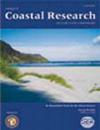用于海岸人工化和复原力绘图的新环境指标
4区 地球科学
Q3 Earth and Planetary Sciences
引用次数: 2
摘要
ABSTRACT T EJADA , M., M ALVAREZ , G.C. and N AVAS , F., 2007.用于海岸人工化和复原力绘图的新环境指标。Journal of Coastal Research, SI 50 (Proceedings of the 9th International Coastal Symposium), 67 - 71.在这一过程中,需要对海岸带和海岸带生态系统进行全面的评估。然而,在应对沿海地区社会经济驱动因素的真正复杂性时,分析和诊断方法并不尽如人意。绘制沿岸土地利用及其时间变化图可以对人为化分析进行一阶近似分析,尽管它显示的只是一瞬间的情况。本文介绍了一种指标,它可以比较已开发海岸在相当长的时间跨度内土地利用的演变及其空间行为。该方法应用于西班牙南部太阳海岸托雷莫利诺斯高度发达的海岸线,包括:(i) 绘制 40 多年来一系列土地利用覆盖范围的照片;(ii) 实施一种新算法,以识别土地利用的变化,并计算 1 公里缓冲边缘内与海岸线相关的变化距离;(iii) 通过复原力的概念,将土地利用的可变性按限定条件转移到绘制的海岸线上,以实现分析的制图输出。在选定的试点地点和时间范围内实施该方法的结果表明,解释复原力的能力很强(超出了单个科学家的认知范围)。人工化过程被量化并在地图上表示出来,这有助于根据趋势定位潜在的高复原力和低复原力(如恢复能力)区域。绘制的结果和最终的复原力地图说明了这一点,可用于未来发达海岸的沿海管理决策。本文章由计算机程序翻译,如有差异,请以英文原文为准。
A New Environmental Indicator for Coastal Artificialisation and Resilience Mapping
ABSTRACT T EJADA , M., M ALVAREZ , G.C. and N AVAS , F., 2007. A New Environmental Indicator for Coastal Artificialisation and Resilience Mapping. Journal of Coastal Research, SI 50 (Proceedings of the 9th International Coastal Symposium), 67 – 71. Gold Coast, Australia, ISSN 0749.0208 Scientists and managers have developed and improved coastal protection and sustainable development measures. However, analysis and diagnostic methods are less than satisfactory when coping with the true complexity of socio economic drivers in coastal areas. Mapping of land use and its temporal variability in the coastal lands enables a first order approximation to the analysis of artificialisation although it shows a snap shot of the situation. An indicator which compares the evolution of land uses over a significant time span in the evolution of a developed coast as well as its spatial behaviour is introduced in this paper. The method, applied on the highly developed coastlines of Torremolinos in Costa del Sol, southern Spain, involves (i) mapping of a series of photo interpreted land use coverage stretching over 40 years; (ii) the implementation of a new algorithm that identifies land use change and calculates distance of change in relation to shoreline across a 1 km. buffer fringe; and (iii) transposing land use variability by qualifying via the concept of resilience onto the mapped shoreline to enable cartographic output of the analysis. Results of the implementation of the method on the selected pilot site and timeframe illustrate a high capability to interpret resilience (beyond sole scientist’s perception). The process of artificialisation is quantified and represented on a map which helps locating areas of potential high and low resilience (as in capacity to recover) given the trends. This is illustrated by mapped results and a final resilience map that could be of use for future decision making in the context of coastal management of developed coasts.
求助全文
通过发布文献求助,成功后即可免费获取论文全文。
去求助
来源期刊

Journal of Coastal Research
地学-地球科学综合
自引率
0.00%
发文量
87
审稿时长
3-8 weeks
期刊介绍:
The Journal of Coastal Research (JCR) is one of the leading international journals for coastal studies and processes, and is published bi-monthly by the Coastal Education & Research Foundation [CERF]. By covering the entire field of coastal research, the JCR encompasses all subjects relevant to natural and engineered environments (freshwater, brackish, or marine) and the protection/management of their resources in the vicinity of coastlines of the world. Even though the journal broadly focuses on immediate shoreline zones, the JCR also embraces those coastal environments that either reach some indefinite distance inland or that extend seaward beyond the outer margins of the sublittoral (neritic) zone. The JCR disseminates accurate information to both the public and research specialists around the world on all aspects of coastal issues in an effort to maintain or improve the quality of our planet''s shoreline resources.
 求助内容:
求助内容: 应助结果提醒方式:
应助结果提醒方式:


